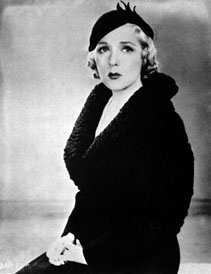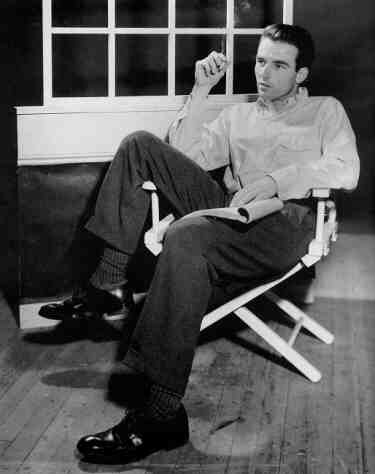

Director Billy Wilder, silent screen great Mary Pickford (an early choice for Norma Desmond), and Montgomery Clift (who dropped out from the role of Joe Gillis two weeks prior to filming)
| The Story |
| The Cast |
| sunset blvd |
| View Guestbook |
| Sign Guestbook |
| Related Sites |
|
|
|
|
|
|
In 1949, the acclaimed writing team began work on their final collaboration. The idea for the film came quite simply: While brainstorming for a new idea, Wilder said to Brackett, "How about an old star who has lost her standing in the interregnum of silent pictures and sound pictures?" With that thought, Sunset Boulevard was born.
Wilder and Brackett brought in a third writer, D.M. Marshman, Jr., who had been a critic for Life magazine. It was Marshman who suggested that the film could also explore the relationship between a faded movie star and a young man.
With the concept at hand, the trio needed to find a film legend whose talents and image could be shaped into the tragic heroine in their idea. The role of Norma Desmond was originally offered to Mae West, whose last screen appearance had been in 1943. Billy Wilder had initially envisioned Norma as a bombshell, full of earthy sex appeal. The film was envisioned to be an outrageous satire on ambition which would also unmask the politics of Hollywood. Miss West, however, showed no interest in the role. Without her, the project took on a different tone, and the character of Norma evolved into its final, tragic, faded-glamour queen concept.
The role was then offered to silent film great Pola Negri, who after emigrating from Germany had a successful film career and an intriguing love affair with Rudolph Valentino. Wilder found her in San Antonio and telephoned her. He found that her thick Polish accent made her English nearly unintelligible, which for obvious reasons was unacceptable in a dialogue-heavy film like Sunset Boulevard.
And so, the search for the leading lady went on. Mae Murray was considered. Brackett and Wilder even went to Pickfair, to offer the role to the legendary Mary Pickford. Wilder remembers: "...halfway through (the pitch), we saw her fallen face was falling some more, as if she was saying, 'Are they mad? This is me, Mary Pickford, America's darling. I am to play a woman who seduces a writer 20 years younger and gives him presents?' So, in the middle of it, we stopped, and said, 'Miss Pickford, we are in grave error. This is certainly not the way that we remember you, the way you were at your height. Forgive us,' and we backed out of the house."
And so the film was still without its star. Until director George Cukor suggested Gloria Swanson. Swanson was living in New York at the time, and was telephoned by Wilder. Swanson was extremely surprised to receive the call; she had been out of show business for so many years. She was also annoyed by the fact that she was being called not to be cast in the film, but to do a screen test. "What the hell do you have to test me for," she asked. "You want to see if I'm alive, do you? Or do you doubt that I can act?"
Cukor subsequently called her to plead Wilder's case. He assured her that Wilder and Brackett were the hottest young team in Hollywood. As Swanson recalled: "He said that this was the greatest part of my life and I'd be remembered for this part. So I took the test." And the film finally had its star.
The rest of the casting went on smoothly. Montgomery Clift agreed to take on the role of the young writer, Joe Gillis. He was extremely hot property in Hollywood, having been nominated as Best Actor in the Academy Awards for his very first film role, in 1948's The Search. The other cast members willingly signed on, including silent screen greats Buster Keaton, H.B. Warner, Anna Q. Nilsson, director Cecil B. DeMille, and gossip columnist Hedda Hopper, all of whom would add touches of realism to the tragic Hollywood tale.
However, two weeks before filming, Clift backed out, saying, "I don't think I can be convincing making love to a woman twice my age." Wilder was outraged. He said, "If he's any kind of actor, he could be convincing making love to any woman!" As the start date of filming was fast approaching, they decided to go through the list of Paramount contract players, and selected William Holden. Swanson was apprehensive about the casting of the 31-year-old Holden, feeling that their age difference would not be pronounced enough. She balked at the idea of making her look older with make-up, suggesting to Wilder: "Can't you use make-up on Mr. Holden instead, to make him look more youthful?"
Holden, too, had his own apprehensions. After accepting the role, he told his wife, "I'm scared. I've agreed to do this picture and I'm not sure I can deliver." The film's eventual success would prove all their worries to have been unfounded.
Filming commenced on April 11, 1949.
 |
 |
From left to right:
Director Billy Wilder, silent screen great Mary Pickford (an early choice for Norma Desmond), and Montgomery Clift (who dropped out from the role of Joe Gillis two weeks prior to filming) |
|